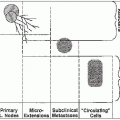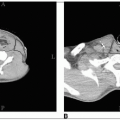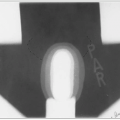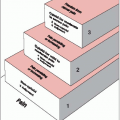Primary bone neoplasms are rare.
The most common skeletal bone tumors are osteosarcoma (excluding myeloma), Ewing’s sarcoma, chondrosarcoma, fibrosarcoma, malignant fibrous histiocytoma of bone, giant cell tumor, aneurysmal bone cyst, and chordoma.
Ewing’s sarcoma is discussed separately later in this chapter.
Osteosarcomas occur in the diaphyseal region of bones of the extremities in 90% of cases, particularly in the distal femur or proximal tibia (24).
Chondrosarcomas are truncal 75% of the time; involved sites include the shoulder girdle, proximal shoulder, and humerus.
Like osteosarcomas, fibrosarcomas (malignant fibrous histiocytomas and malignant giant cell tumors) often occur in the femur or tibia; however, unlike osteosarcomas, most are in the metaphyseal or epiphyseal region.
Chordomas are malignant tumors arising from embryonic notochord remnants. Fifty percent originate in the sacrococcygeal region, 35% in the base of the skull, and 15% in the spine.
Aneurysmal bone cysts can occur in any bone, but most frequently occur in lower extremity long bones and vertebrae.
Osteosarcomas usually present with local swelling and pain of the involved area. Joint effusion and pathologic fracture at presentation are uncommon.
Metastases from osteosarcoma are present in 17% of patients at diagnosis and in 80% at 18 months. The primary mode of hematogenous spread initially results in pulmonary metastases (98%), followed by bone (37%), pleura (33%), and heart (20%) (10, 40).
Chondrosarcomas are more locally aggressive and follow a more indolent course than osteosarcomas.
Like osteosarcomas, chondrosarcomas commonly metastasize to the lungs and may dedifferentiate to aggressive fibrosarcomas or osteosarcomas (10).
Chondrosarcomas in the pediatric population are aggressive and behave like classic osteosarcomas (34).
Pathologic fractures are more common with fibrosarcomas and malignant fibrous histiocytomas of bone than with other types of bone tumors.
The histologic grade of the fibrosarcoma determines how it behaves. High-grade fibrosarcomas are locally aggressive and behave like osteosarcomas, resulting in a 5-year survival rate of 27% (11). Periosteal and low-grade fibrosarcomas are less aggressive, with 5- and 10-year survival rates of 50%.
The clinical symptoms of chordoma depend on its location. Pain and abnormal gait may be related to cord compression or nerve root compression, which predominate in paraspinal and sacrococcygeal lesions.
Chordomas are slowly growing, locally malignant tumors that present late in the disease or with very large primary lesions (33). They have a 10% to 25% incidence of metastases.
Malignant fibrous histiocytoma of bone is very aggressive locally and has a high rate of lung metastases, with most recurrences appearing within 21 months of diagnosis (13). Malignant transformation of benign giant cell tumors must be strongly suspected if recurrence is discovered more than 5 years after treatment. Malignant degeneration after surgery is usually of lower histologic grade than after radiation therapy.
Table 43-1 outlines the suggested diagnostic workup for malignant bone tumors.
Standard imaging techniques include plain x-ray films, computed tomography (CT) and magnetic resonance (MR) imaging of the affected bone and surrounding soft tissues, and a whole-body radionuclide bone scan (11, 14).
Plain films and CT scans of the lung are necessary because of the high rate of metastases.
CT and MR imaging are important in evaluating chordomas because of the soft tissue component. Other radiologic features of chordoma include irregular bone destruction, with or without areas of calcification.
The typical presentation of malignant fibrous histiocytoma (with or without a pathologic fracture, which is common) is a predominantly metaphyseal radiolucent lesion, frequently with epiphyseal extension.
It is not possible to differentiate a benign from a malignant giant cell tumor by radiographic examination (7, 11, 14).
TABLE 43-1 Diagnostic Workup for Bone Tumors
General
History
Physical examination
Special Studies
Open biopsy, avoiding incision over area not to be irradiated
Bone marrow aspiration and biopsy (for Ewing’s sarcoma)
Radiologic Studies
Standard
Plain radiography of bone and chest
CT of affected bone, surrounding soft tissue, and lungs
Radionuclide bone scan
MR imaging of affected bone and surrounding soft tissue
Optional
Angiography
Laboratory Studies
Complete blood cell count on admission
Blood chemistry profile
Urinalysis
Erythrocyte sedimentation rate
Aneurysmal bone cysts are usually well-defined, expansile metaphyseal or diaphyseal lesions characterized by a blowout appearance with internal septa and ridges (14).
There is no universally accepted staging system for primary bone sarcomas.
The Enneking staging system classifies tumors according to grade, local extent, and presence or absence of distant metastases (15) (Table 43-2). The new AJCC staging definitions are given in Table 43-3.
Classic osteosarcoma is usually poorly differentiated; 85% of lesions are grade 3 or 4, with varying amounts of cyst formation, hemorrhage, and necrosis. The last three points are important when radiosensitivity is being considered.
TABLE 43-2 Enneking Staging System for Bone Sarcomas
Grade (G)
G1, low grade
Parosteal osteosarcoma Endosteal osteosarcoma Secondary chondrosarcoma Fibrosarcoma, low grade Atypical malignant fibrous histiocytoma Giant cell tumor Adamantinoma
G2, high grade
Classic osteosarcoma Radiation-induced sarcoma Paget’s sarcoma Primary chondrosarcoma Fibrosarcoma, high grade Malignant fibrous histiocytoma Giant cell sarcoma
Local Extent (T)
T1, intracompartmental
Intraosseous Paraosseous
T2, extracompartmental
Soft tissue extension Extrafascial or deep fascial extension
Metastases (M)
M0
No distant metastases
M1
Distant metastases exist
Staging Grouping
IA
G1
T1
M0
IB
G1
T2
M0
IIA
G2
T1
M0
IIB
G2
T2
M0
III
G1 or G2
T1 or T2
M1
Source: From Enneking WF, Spanier SS, Goodman MA. A system for staging musculoskeletal sarcoma. Clin Orthop 1980;153:106, with permission.
TABLE 43-3 American Joint Committee on Cancer Staging Definitions for Bone Cancer
Primary Tumor (T)
TX
Primary tumor cannot be assessed
T0
No evidence of primary tumor
T1
Tumor 8 cm or less in greatest dimension
T2
Tumor more than 8 cm in greatest dimension
T3
Discontinuous tumors in the primary bone site
Regional Lymph Nodes (N)
NX
Regional lymph nodes cannot be assessed
N0
No regional lymph node metastasis
N1
Regional lymph node metastasis
Distant Metastasis (M)
M0
No distant metastasis (no pathologic M0; use clinical M to complete stage group)
M1
Distant metastasis
M1a
Lung
M1b
Other distant sites
Source: Staging from Edge SB, Byrd DR, Compton CC, et al., eds. AJCC cancer staging manual, 7th ed. New York, NY: Springer Verlag, 2009, with permission.
“Skip” bone metastasis may be seen with osteosarcomas. It consists of a second, smaller focus of osteosarcoma in the same bone or a second bone lesion on the opposing side of a joint space, with no gross or microscopic continuity or pulmonary metastases.
Grade is an important prognostic indicator in chondrosarcomas, which are graded 1 to 3.
Malignant fibrous histiocytoma of bone is a primitive, undifferentiated pleomorphic sarcoma. The extent of local spread on pathologic examination is almost always greater than is visible in routine radiography (11).
Grade is not a reliable prognosticator in giant cell tumors or osteoclastomas.
Massive spindle cell sarcomatous stroma is seen in malignant giant cell tumors.
The most important factor in osteosarcoma is metastasis at presentation. Radiation-induced osteosarcoma has a worse prognosis.
Prognostic factors in chondrosarcoma include histologic grade, size, cell type, location, stage at presentation, patient age, degree of local aggressiveness, and presence or absence of pain at presentation (22). Metastases developed in 0% of patients with grade 1 chondrosarcoma, 10% with grade 2, and 73% with grade 3 (36).
The metastatic rate for low-grade fibrosarcoma is 5% to 15%; the rate of distant metastasis for high-grade fibrosarcoma is equal to that of osteosarcoma (34). The overall 5-, 10-, and 20-year survival rates are 34%, 28%, and 25%, respectively (22).
The most important prognostic indicators for chordoma are site of origin and local extension of tumor (2, 9).
Although malignant fibrous histiocytoma is very aggressive with a poor prognosis (34), researchers at Johns Hopkins University found that these lesions are less aggressive than fibrosarcomas and osteosarcomas (27). Survival rates of 58% and 43% at 5 and 10 years, respectively, have been reported (11).
Initial management includes a small incision for biopsy and meticulous closure to promote healing.
Patients treated with less radical (limb-salvage) surgery have the same survival characteristics as those treated with more aggressive procedures.
Stay updated, free articles. Join our Telegram channel

Full access? Get Clinical Tree








